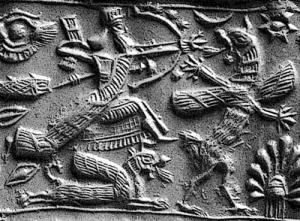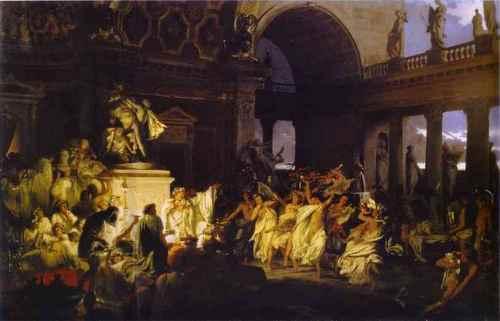Snowflakes in the air
Carols everywhere
Olden times and ancient rhymes
Of love and dreams to share. - Lee Mendelson, “Christmas Time is Here”
As I said yesterday, I suspect the festival we now know as Christmas began about 3900 BCE, when the climate abruptly cooled and dried all over the world. For about 2000 years before that, the climate had been wet and warm enough for agriculture to succeed even in areas which are arid in modern times, and with little irrigation or centralized planning. But once the long drought set in (around the same time copper started to replace stone as the favored tool material), everyone started to crowd into the comparatively small areas of the river valleys: scattered villages gave way to large cities, wars were fought over the limited arable land, and hierarchical social structures appeared in order to keep track of which land belonged to whom and what would happen to it when he died. Because warfare and rigid hierarchies appeal more to the male mind societies became more patriarchal, and because heredity was now important sex laws and taboos started to appear. Now that agriculture was a bit trickier calendars were needed so people would know the best times to plant and to reap, and rituals were developed to appease the gods so as to ensure bountiful harvests.
 By the late 4th millennium BCE, the most important of these rites was the one which commemorated the creation of the world by the sky-god Anu after his victory over the forces of chaos; the Babylonians assigned this role to their god Marduk, and personified chaos as the dragon Tiamat. The battle was believed to have lasted for 12 days, so the festival (which the Babylonians called Zagmuk) did as well, and though it occurred at the end of winter (the two weeks before the vernal equinox) rather than at the beginning, this was the origin of our 12 days of Christmas. As in many later cultures, the time between the end of the old year and the beginning of the new was a time of chaos, and the rituals were thought to help Marduk beat back Tiamat for another year. The priests and nobles enacted a pageant (the ancestor of our Christmas pantomime) in which the king played Marduk, and he was supposed to be sacrificed so as to join the god in the underworld and fight by his side. But because it was impractical (not to mention counterproductive) to have a new king every year, what actually happened was this: on the first day of Zagmuk, the king abdicated his power and a condemned criminal was invested as king. He was feted and given homage, and played the part of Marduk in the early part of the festival; he was then sacrificed and the true king resumed his station, receiving the power to rule by consummating a ritual marriage with the entu (high priestess of Ishtar). To provide a mystical balance, another prisoner was chosen at the same time as the temporary king; instead of being sacrificed, he was set free in order to bear the sins of the nation away with him (a similar ritual was later practiced by the Hebrews using goats). And while the ruling classes enacted all this, the common people helped by burning effigies of Tiamat in bonfires.
By the late 4th millennium BCE, the most important of these rites was the one which commemorated the creation of the world by the sky-god Anu after his victory over the forces of chaos; the Babylonians assigned this role to their god Marduk, and personified chaos as the dragon Tiamat. The battle was believed to have lasted for 12 days, so the festival (which the Babylonians called Zagmuk) did as well, and though it occurred at the end of winter (the two weeks before the vernal equinox) rather than at the beginning, this was the origin of our 12 days of Christmas. As in many later cultures, the time between the end of the old year and the beginning of the new was a time of chaos, and the rituals were thought to help Marduk beat back Tiamat for another year. The priests and nobles enacted a pageant (the ancestor of our Christmas pantomime) in which the king played Marduk, and he was supposed to be sacrificed so as to join the god in the underworld and fight by his side. But because it was impractical (not to mention counterproductive) to have a new king every year, what actually happened was this: on the first day of Zagmuk, the king abdicated his power and a condemned criminal was invested as king. He was feted and given homage, and played the part of Marduk in the early part of the festival; he was then sacrificed and the true king resumed his station, receiving the power to rule by consummating a ritual marriage with the entu (high priestess of Ishtar). To provide a mystical balance, another prisoner was chosen at the same time as the temporary king; instead of being sacrificed, he was set free in order to bear the sins of the nation away with him (a similar ritual was later practiced by the Hebrews using goats). And while the ruling classes enacted all this, the common people helped by burning effigies of Tiamat in bonfires.
Sumer was the Great Mother of Western civilization, and her culture infused all which came after it. The Zagmuk festival spread to all parts of the Near East, and though it changed as it spread its influence can be clearly seen. The dedication of a human sacrifice to represent the death of the god, followed immediately by the investiture of another person as the reborn god, was adopted by the Ancient Greeks as part of their primitive festival of Lenaea. And while the human sacrifice eventually vanished in a literal sense from the Babylonian festival (later called Akitu), it survived in symbolic form; during the twelve days of the festival the social order was reversed, with masters waiting upon slaves and one slave chosen to be the head of the household for the duration, just as a criminal had been made king in earlier times (but without the unpleasant conclusion). And after the battle-pageant the common people thronged in the street, rejoicing in the victory of their god with shouted invocations and joyful songs. The festival was extremely popular, and survived conquest after conquest for millennia; the Kassites, Elamites, Assyrians, Chaldeans, Persians and Seleucids each adopted it in turn. By late classical times many of its elements (including the social reversal and the singing in the streets) had entered the Greek Kronia, descendant of Lenaea and ancestor of the Roman Saturnalia; the latter adopted its practices wholesale in 217 BCE, at the same time (and as part of the same Sibylline reform) as the Venus Erycina was brought to Rome.
Six thousand years ago the climate shifted, driving our ancestors from a pleasant Eden where food was plentiful into a harsher world where winter was a time of crisis. And though the elaborate ritual devised by the ancient Mesopotamians to drive back the chaos is no longer solemn or bloody, many of its elements – feasting, mumming and masking, pantomime, bonfires, caroling and even the twelve-day duration – became traditional parts of our winter holiday season, and have endured even to the present day. From the unnamed festival of ancient Uruk to Zagmuk to Lenaea and Akitu, then via Kronia to Saturnalia to Sol Invictus, and finally to Christmas and Carnival, there runs one long, unbroken cord which none who opposed it, whether king, priest or ideologue, has ever been able to sever.
